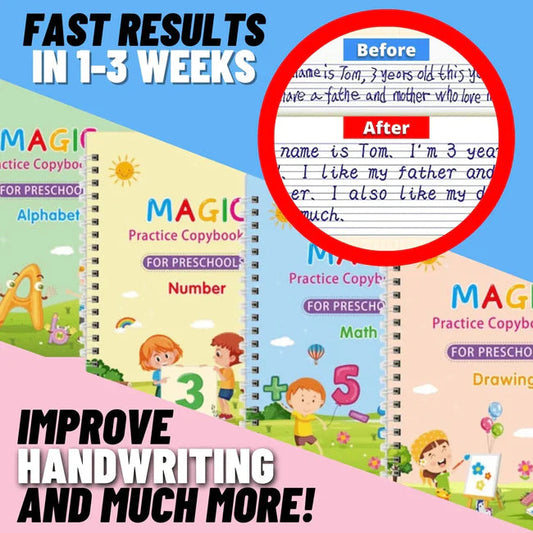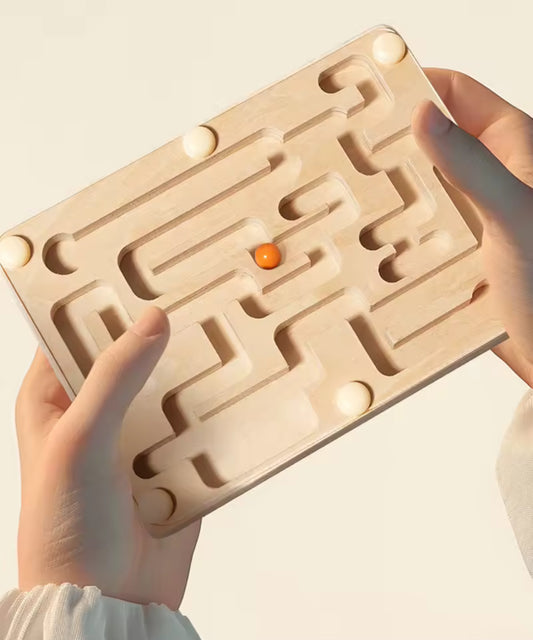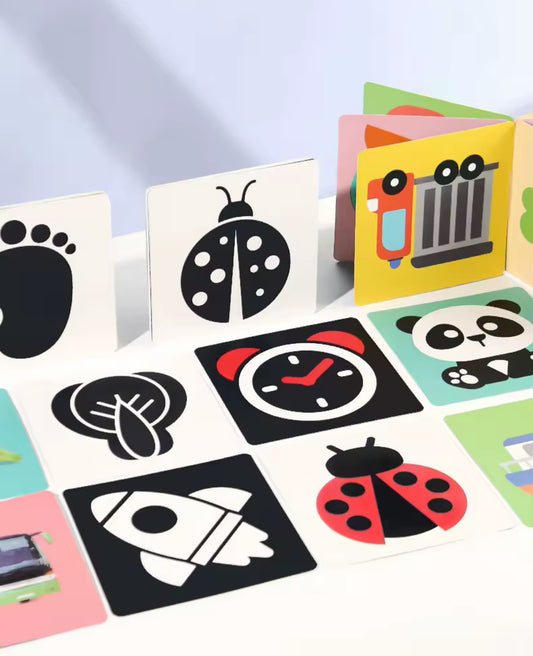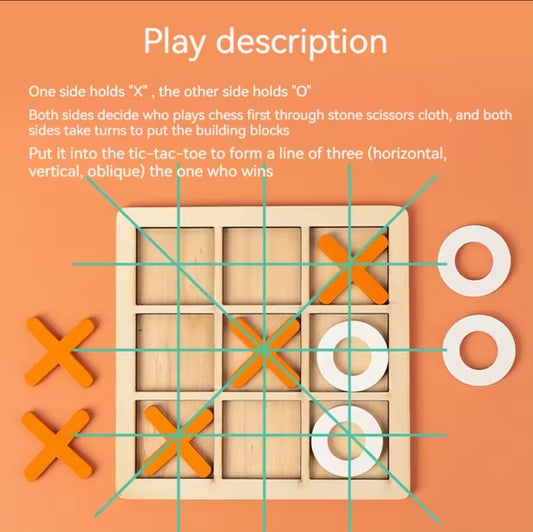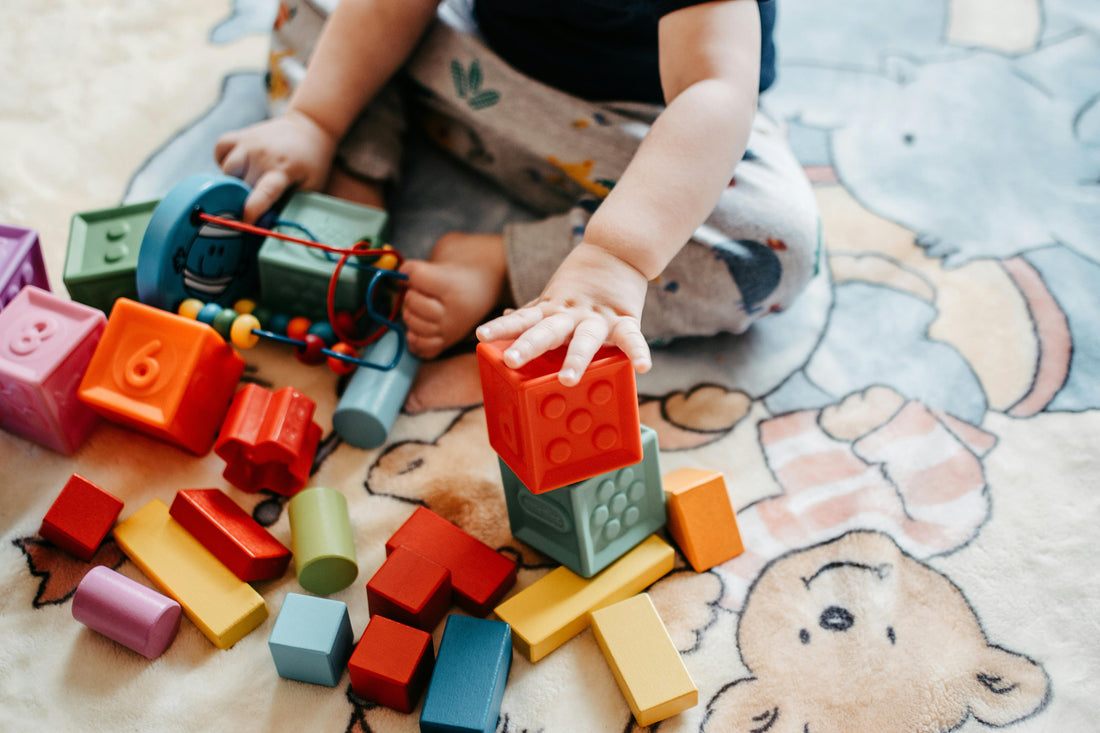
Nurturing Growth: Baby Development Toys & Milestones
Share
Watching a little one grow is one of life’s greatest joys. From the first coos to those wobbly first sits, each stage is full of wonder. One of the most magical times is baby development at 6 months, this is when your baby is becoming more aware, interactive, and ready for more stimulating toys. In this post I’ll walk you through stages of baby development, particularly around six months, and suggest some smart toys that help support that growth- including examples like FirstSparks Baby Vision Cards and Tic-Tac-Go! Montessori Board Game.
The Stages of Baby Development (0–12 months, with a focus on 6 months)
Babies don’t grow in leaps and bounds all at once - their progress is gradual and happens in overlapping stages. Here’s a rough roadmap:
0-3 months: Lifting head, beginning to track objects, recognizing caregivers.
3-6 months: More control of hands and arms, reaching, grasping, rolling, exploring textures.
6-9 months: Sitting (unassisted or with support), babbling, possibly beginning to crawl, exploring cause and effect (dropping things, banging toys).
9-12 months: Pulling to stand, cruising, deliberate pointing, first steps for many, combining sounds or words.
At 6 months, your baby may begin to:
- Sit with less support or briefly unassisted
- Transfer objects between hands
- Engage more with patterns, faces, and contrast
- Babble with more consonant sounds (“ba,” “ma”)
- Show curiosity - reaching for toys, exploring surfaces or edges
This phase is a sweet spot for introducing toys that spark sensory exploration, fine motor skills, and visual tracking.
Why Toys Matter (and How to Choose Them)
When chosen thoughtfully, baby development toys do more than entertain - they help build neural connections, hand eye coordination, curiosity, and concentration. But not every toy is optimal at every age. Look for characteristics such as:
- High-contrast visuals (black/white or bold patterns) early on
- Textures and safe surfaces for exploration
- Simple cause-and-effect features (shake, rattle, drop)
- Incremental challenge (as your baby’s skills grow)
- Safe size (no choking hazards)
As your baby moves through stages, you’ll shift from purely sensory toys toward ones that encourage problem-solving and intentional play
Toy Ideas Around 6 Months and Beyond
Below are some toy ideas and how they map onto development. I’ll include specific product examples to spark your imagination.
1. Visual Stimulation & Tracking
At six months, your baby’s vision is sharpening. High-contrast, bold patterns are still engaging, and gradually more color emerges. A great example is:
- FirstSparks Baby Vision Cards - These are thick, non-toxic, high-contrast cards designed to support early visual tracking, focus, and cognitive development.
The cards come in stages (0–3 months, 3–6, 6–12, etc.), so as your baby’s sight improves, you can switch to more nuanced designs. Use them during tummy time, or hold them a safe distance away and move slowly side to side to let your baby practice tracking.
These kinds of visual tools help the eyes and brain coordinate better, building the foundation for depth perception, object recognition, and more advanced visual skills.
2. Tactile & Grasping Toys
By six months, babies often begin voluntarily reaching, grasping, and transferring toys between hands. Toys with different textures, safe edges, or soft parts are especially helpful. Some ideas:
- Soft fabric books or crinkly pages
- Silicone teethers
- Small rattles with easy-to-grip handles
- Stackable cups or rings (large enough to avoid choking risk)
These support fine motor development and sensory integration (touch, pressure, texture).
3. Cause-and-Effect & Interactive Play
One of the joys of the 6-9 month range is babies beginning to understand cause-and-effect: “If I drop it, it falls.” Toys that respond to action-by sound, light, or movement-are especially engaging. Examples:
- Shake toys or rattles
- Pop-up toys
- Soft blocks with noise inside
- Activity balls with internal beads
These help babies experiment and test their actions, which is critical for cognitive growth
4. Early Logic / Simple Problem Solving
As your baby nears 9-12 months (and even a bit earlier with help), you can begin introducing very simple problem-solving toys-puzzles with big knobs, nesting cups, or simple object permanence boxes (hide-and-seek). While some toys are targeted at toddlers, you can preload or scaffold them so your baby will grow into the toy.
An example from Bambino Bee, although for older ages, is:
- Tic-Tac-Go! Montessori Board Game - This is a Montessori-inspired game with minimalist design, natural wooden materials, and tactile tokens. While marketed for slightly older children, it demonstrates a thoughtful approach: simple, natural, no overstimulation. You might keep it around and introduce it as your child advances, or adapt the concept (e.g. letting baby handle the wooden tokens under supervision)
Sample Play Routine at 6 Months
Here’s a simple daily routine to weave in developmental play:
1. Tummy Time with Vision Cards
Begin with a few minutes of tummy time with a FirstSparks Baby Vision Cards card placed within view (but not too close)- move it slowly to encourage tracking.
2. Grasp & Texture Time
Offer soft rattles, fabric swatches, or a teether. Let baby explore textures, grasp, and drop. Sit opposite so you can admire and talk about each texture.
3. Interactive Session
Hold or present a rattle or toy that makes noise when squeezed or shaken. Pause and let baby initiate-this builds anticipation and agency.
4. Object Drop/Cause and Effect
Sit baby upright (supported) and give them a safe container and a soft toy. Encourage them to drop the toy and retrieve it. Watch how they begin to experiment.
5. Quiet Visual Play/Wind-down
Toward the end of the day, show a vision card or soft visual book. Let baby gaze, point (if they’re starting), or mouth edges (if safe).
You’d repeat, mix, and adapt sessions over days as baby’s skills evolve
Tips for Parents & Caregivers
Watch cues. If baby is fussy, tired, or overstimulated, pause. Short, frequent bursts of play are better than long forced sessions.
Rotate toys. Don’t overwhelm with too many at once. Rotate in new ones gradually.
Talk and narrate. Even if baby isn’t responding verbally yet, narrating what they see, feel, or hear helps language development.
Be present. Your engagement (eye contact, smiles, mimicking) is as important as the toy itself.
Safety first. Always inspect toys for loose parts, choking risks, or hazards. Use age recommendations as guidelines, not absolutes
Looking Ahead: From 6 Months to the Next Stage
As your baby approaches 9-12 months, you’ll find they’re ready for more advanced toys: stacking cubes, nesting cups, simple peg puzzles, push-pull toys, and finally early games of cause and effect. The key is to scaffold -start simple, then build in complexity.
Though Tic-Tac-Go! Montessori Board Game is designed more for toddlers, it underscores a valuable philosophy: toys built with respect for the child’s pace, minimal distraction, and natural materials. You can adapt that spirit into early toys, focusing on clarity, quality, and purposeful design.
In sum, nurturing baby development at 6 months is about encouraging curiosity, giving safe and stimulating opportunities, and supporting each step gently. By understanding the stages of baby development, you can choose and use toys more intentionally, giving your baby both joy and growth.



